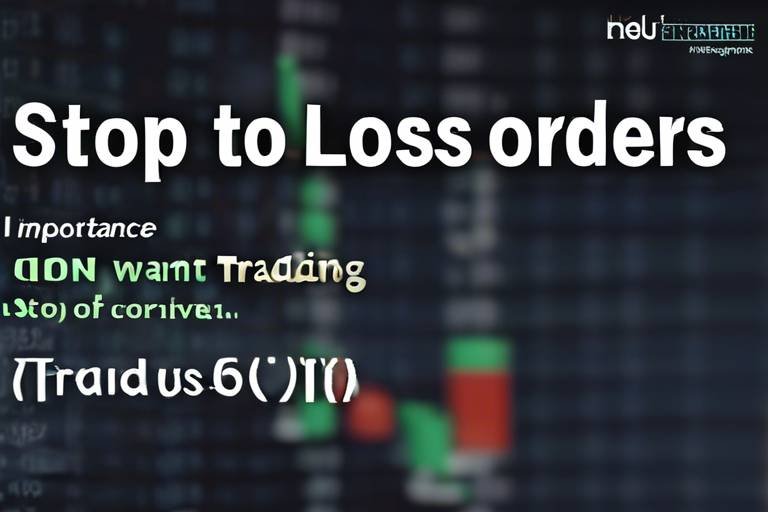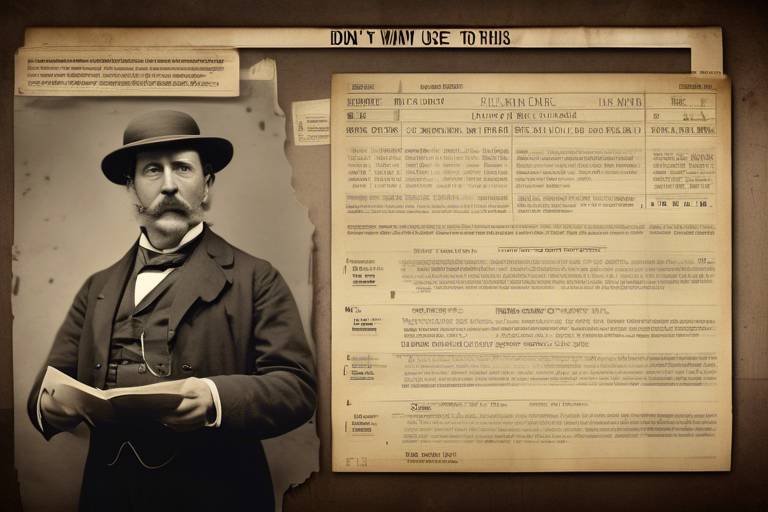Exploring Different Trading Styles
In the vast world of trading, it's crucial to find a style that resonates with your personality, risk tolerance, and financial goals. Just like a chef has a signature dish, every trader has a unique approach that suits their individual needs. Exploring different trading styles can feel like wandering through a bustling marketplace, each stall offering something enticing yet distinct. Whether you're a novice trying to find your footing or an experienced trader looking to refine your strategies, understanding these styles can significantly impact your trading journey.
Trading isn't just about buying low and selling high; it's about timing, analysis, and, most importantly, knowing yourself. Are you someone who thrives on adrenaline, or do you prefer a more laid-back approach? By diving into the various trading styles, you can identify which method aligns best with your trading philosophy. This exploration can lead to more informed decisions, better risk management, and ultimately, a more fulfilling trading experience.
Throughout this article, we will break down the most popular trading styles, including day trading, swing trading, position trading, and scalping. Each style has its own set of characteristics, advantages, and challenges. For instance, day trading is like a high-speed race where every second counts, while position trading resembles a long, scenic road trip where patience is key. By understanding the nuances of each style, you can tailor your approach to fit your unique trading persona.
As we delve deeper into each trading style, we'll discuss not only the strategies and tools involved but also the mindset required to succeed. After all, trading isn’t merely about the numbers; it’s also about psychology. In the end, the goal is to equip you with the knowledge to navigate the trading landscape confidently. So, buckle up as we embark on this journey through the dynamic world of trading styles!
- What is the best trading style for beginners?
For beginners, swing trading is often recommended as it allows more time to analyze trades without the pressure of daily fluctuations.
- Can I combine different trading styles?
Absolutely! Many traders find success by blending elements from different styles to create a hybrid approach that suits their unique situation.
- How do I know which trading style is right for me?
Consider your personality, risk tolerance, and the amount of time you can dedicate to trading. Testing different styles in a demo account can also help you find your fit.

Day Trading
Day trading is an exhilarating approach to the financial markets, where traders buy and sell financial instruments within the same trading day. Imagine being in a high-stakes game where every second counts, and your decisions can lead to significant profits or losses. This style appeals to those who thrive on excitement and can handle the pressures of rapid decision-making. To be successful, day traders need to develop a specific mindset and utilize effective strategies and tools.
One key aspect of day trading is the ability to analyze short-term price movements. Traders often use technical analysis, which involves studying price charts and indicators to forecast future movements. It's like being a detective, piecing together clues from past price patterns to predict what might happen next. A common strategy is to focus on high-volatility stocks, as they provide more opportunities for profit within a single day.
In addition to technical analysis, day traders rely on a variety of tools to enhance their trading performance. These tools can range from advanced charting software to real-time news feeds. For instance, platforms like MetaTrader or Thinkorswim offer powerful features that allow traders to execute trades quickly and efficiently. Here’s a quick overview of essential tools:
| Tool | Purpose |
|---|---|
| Charting Software | Visualize price movements and identify patterns |
| News Aggregators | Stay updated on market-moving news |
| Trading Platforms | Execute trades quickly and manage orders |
Moreover, having the right mindset is crucial for day traders. It’s not just about making money; it’s about controlling emotions and maintaining discipline. Fear and greed can lead to impulsive decisions, which can be detrimental. Successful day traders often stick to a well-defined trading plan, which includes entry and exit strategies, as well as risk management techniques to protect their capital.
In conclusion, day trading is not for the faint-hearted. It requires a unique combination of skills, tools, and mental fortitude. If you’re ready to dive into the fast-paced world of day trading, remember to do your homework, practice with a demo account, and develop a solid trading strategy. This way, you can navigate the thrilling ups and downs of the market with confidence!
- What is day trading? Day trading involves buying and selling financial instruments within the same day, aiming to capitalize on short-term price movements.
- Do I need a lot of money to start day trading? While you can start with a smaller amount, having a larger capital can provide more flexibility and opportunities.
- What tools do I need for day trading? Essential tools include charting software, trading platforms, and news aggregators to stay informed about market conditions.

Swing Trading
Swing trading is an exciting approach that allows traders to capitalize on short- to medium-term price movements in the market. Unlike day trading, which requires constant attention and quick decision-making, swing trading provides a bit more flexibility. Traders typically hold positions for several days to weeks, aiming to profit from the natural "swings" in stock prices. Imagine it like riding a roller coaster; you don't need to be on the ride at all times, but you want to catch the thrilling ups and downs when they occur.
One of the key attractions of swing trading is its potential for high returns with less time commitment than day trading. This makes it suitable for those who may have other commitments, like a full-time job or family responsibilities. However, swing traders must still be vigilant and disciplined, as the market can be unpredictable. They need to stay informed about market trends, economic indicators, and potential news events that could impact their trades.
To succeed in swing trading, traders often rely on a mix of technical analysis and fundamental analysis. Technical analysis helps traders identify entry and exit points based on price patterns and market trends. On the other hand, fundamental analysis allows traders to understand the underlying factors that may influence a stock's price over time. For example, a swing trader might analyze earnings reports, economic data, and industry news to gauge the potential for price movements.
Technical analysis plays a crucial role in the swing trading strategy. Traders use various tools to analyze price charts and identify patterns that signal potential trade opportunities. Key indicators such as moving averages, Relative Strength Index (RSI), and the Moving Average Convergence Divergence (MACD) are commonly employed. These indicators help traders assess market momentum and make informed decisions about when to enter or exit a trade.
Among the most favored indicators in swing trading are:
- Moving Averages: These smooth out price data to identify trends over a specific period. Traders often look at the crossover of short-term and long-term moving averages to signal potential buy or sell points.
- Relative Strength Index (RSI): This momentum oscillator measures the speed and change of price movements. An RSI above 70 may indicate overbought conditions, while an RSI below 30 could signal oversold conditions.
- Moving Average Convergence Divergence (MACD): This indicator helps traders identify changes in the strength, direction, momentum, and duration of a trend in a stock's price.
Recognizing chart patterns is essential for swing traders. Some common patterns include:
- Head and Shoulders: This pattern indicates a reversal trend and is often seen as a signal to sell.
- Double Tops: This pattern suggests that the price may not break above a certain level, indicating a potential downturn.
Understanding these patterns can significantly enhance a swing trader's ability to make profitable trades. It’s like having a map while navigating through a dense forest; it helps you avoid pitfalls and find the best path forward.
Effective risk management is vital in swing trading. Traders must implement strategies to protect their capital and minimize losses. This includes setting stop-loss orders to automatically sell a position when it reaches a certain price, thereby limiting potential losses. Additionally, traders should never risk more than a small percentage of their trading capital on a single trade. This way, even if some trades do not go as planned, they will still have enough capital to continue trading.
In conclusion, swing trading offers a unique blend of flexibility and opportunity for traders looking to profit from market fluctuations. By mastering technical analysis, utilizing key indicators, and implementing robust risk management strategies, traders can navigate the markets with confidence and skill.
1. What is the best time frame for swing trading?
Swing traders typically look at daily or weekly charts to make their trading decisions. This allows them to capture price movements over several days or weeks.
2. How much capital do I need to start swing trading?
The amount of capital needed varies, but many traders start with a few thousand dollars. It's essential to have enough capital to manage risk effectively.
3. Can I swing trade part-time?
Absolutely! Swing trading is perfect for part-time traders since it doesn't require constant monitoring of the markets.
4. What are the common mistakes to avoid in swing trading?
Some common mistakes include not having a trading plan, ignoring risk management, and letting emotions dictate trading decisions.

Technical Analysis in Swing Trading
When it comes to swing trading, technical analysis is like having a treasure map that guides traders toward potential profits. By analyzing price movements and trading volumes, swing traders can identify patterns and trends that might otherwise go unnoticed. This analysis is crucial because it helps traders make informed decisions rather than relying solely on gut feelings or market rumors. Imagine trying to navigate a dense forest without a map; that's what trading can feel like without technical analysis!
One of the most powerful tools in a swing trader's arsenal is the use of indicators. These indicators are mathematical calculations based on historical price, volume, or open interest information. They help traders determine whether a market is overbought or oversold, providing insight into potential price reversals. Some of the most popular indicators that swing traders rely on include:
- Moving Averages: These smooth out price data to identify trends over a specific period. By comparing short-term and long-term moving averages, traders can spot potential buy or sell signals.
- Relative Strength Index (RSI): This momentum oscillator measures the speed and change of price movements, helping traders identify overbought or oversold conditions.
- Moving Average Convergence Divergence (MACD): This trend-following momentum indicator shows the relationship between two moving averages of a security’s price, providing insights into potential buy or sell opportunities.
In addition to indicators, recognizing chart patterns is essential for swing traders. These patterns can signal potential reversals or continuations in price movement. Some common patterns that traders often look for include:
- Head and Shoulders: This pattern typically signifies a reversal trend, indicating that a bullish trend may be coming to an end.
- Double Tops: This is another reversal pattern that occurs after an uptrend, signaling that the price may soon decline.
Understanding these patterns is like learning the language of the market; it allows traders to anticipate price movements and make timely decisions. By combining indicators with chart patterns, swing traders can enhance their strategies and increase their chances of success.
However, it's important to remember that no analysis is foolproof. Market conditions can change rapidly, and unexpected events can disrupt even the most well-researched trading plans. Therefore, swing traders must remain adaptable and continuously refine their strategies based on ongoing analysis.
In summary, technical analysis is an indispensable part of swing trading. It equips traders with the tools and knowledge necessary to navigate the complexities of the market. By mastering indicators and chart patterns, swing traders can make more informed decisions, ultimately leading to more successful trades.
What is the primary goal of technical analysis in swing trading?
The primary goal is to identify potential price movements and trends by analyzing historical price data and patterns, allowing traders to make informed decisions.
How do indicators help in swing trading?
Indicators provide insights into market conditions, helping traders identify overbought or oversold situations, which can signal potential entry or exit points.
Are chart patterns reliable for predicting price movements?
While chart patterns can be helpful, they are not always foolproof. It's essential to combine them with other analysis methods and risk management strategies.

Popular Indicators
When it comes to swing trading, having the right indicators at your fingertips is like having a trusty compass on a journey through uncharted territory. These indicators help traders navigate the often choppy waters of the financial markets, providing critical insights into potential price movements. Among the most popular indicators that swing traders rely on are moving averages, the Relative Strength Index (RSI), and the Moving Average Convergence Divergence (MACD). Each of these tools serves a unique purpose and can significantly enhance your trading strategy.
Moving averages, for instance, smooth out price data to create a trend-following indicator. By averaging price points over a specified period, they help traders identify the overall direction of the market. There are two primary types of moving averages: the simple moving average (SMA) and the exponential moving average (EMA). The SMA calculates the average price over a set number of periods, while the EMA gives more weight to recent prices, making it more responsive to new information. Traders often use crossovers between these averages as signals for potential buy or sell opportunities.
The RSI, on the other hand, is a momentum oscillator that measures the speed and change of price movements. Ranging from 0 to 100, the RSI helps traders identify overbought or oversold conditions in the market. A reading above 70 typically indicates that an asset is overbought, suggesting a potential price pullback, while a reading below 30 indicates oversold conditions, signaling a possible price increase. This indicator is invaluable for swing traders looking to time their entries and exits effectively.
Lastly, we have the MACD, which stands for Moving Average Convergence Divergence. This indicator is a trend-following momentum indicator that shows the relationship between two moving averages of a security’s price. The MACD is calculated by subtracting the 26-period EMA from the 12-period EMA, and it generates a signal line (the 9-period EMA of the MACD) that traders use to identify potential buy or sell signals. When the MACD crosses above the signal line, it’s often seen as a bullish signal, while a crossover below can indicate a bearish trend.
To summarize, here’s a quick comparison of these popular indicators:
| Indicator | Type | Purpose |
|---|---|---|
| Moving Averages | Trend Indicator | Identify market direction and potential entry/exit points |
| Relative Strength Index (RSI) | Momentum Indicator | Determine overbought or oversold conditions |
| Moving Average Convergence Divergence (MACD) | Trend & Momentum Indicator | Signal potential buy/sell opportunities based on moving average crossovers |
These indicators are not just numbers and lines on a chart; they are powerful tools that can help you make informed trading decisions. By understanding how to interpret these indicators, you can enhance your swing trading strategy and increase your chances of success in the market. Remember, the key is not just to rely on one indicator but to use them in conjunction with each other, creating a robust trading plan that takes into account various market conditions.
- What is the best indicator for swing trading? While there isn't a one-size-fits-all answer, many traders find that using a combination of moving averages, RSI, and MACD provides a comprehensive view of market conditions.
- Can I use these indicators on any trading platform? Most modern trading platforms offer these indicators, but it's essential to familiarize yourself with how to apply them effectively on your chosen platform.
- How often should I check my indicators? It's advisable to monitor your indicators regularly, especially during active trading hours, to make timely decisions based on market movements.

Chart Patterns
When it comes to swing trading, recognizing is like having a secret map that guides you through the complex world of market movements. These patterns are visual representations of price action and can help traders anticipate future price movements based on historical data. Imagine you’re a detective, piecing together clues from the market to uncover hidden trends. By understanding these patterns, you can make more informed decisions about when to enter or exit a trade.
Some of the most common chart patterns that swing traders look for include the head and shoulders, double tops, and flags. Each of these patterns has its own unique characteristics and implications:
| Chart Pattern | Description | Implication |
|---|---|---|
| Head and Shoulders | A reversal pattern that indicates a change in trend direction. | Potential bearish reversal after an uptrend. |
| Double Tops | A bearish reversal pattern that forms after an upward trend. | Signals a potential trend reversal to the downside. |
| Flags | A continuation pattern that indicates a brief consolidation before the previous trend resumes. | Indicates that the trend (up or down) is likely to continue. |
Understanding these patterns can be a game changer for swing traders. For instance, the head and shoulders pattern is particularly significant as it often signals a strong shift in market sentiment. When you spot this pattern forming on your charts, it’s like a red flag waving, warning you that the bullish trend may be coming to an end. On the other hand, double tops can serve as a confirmation that the market is losing momentum, giving you a chance to capitalize on a potential downturn.
But spotting these patterns is just the beginning. It’s crucial to combine chart pattern recognition with other forms of analysis, such as technical indicators and market sentiment. This holistic approach can help you filter out false signals and make more reliable trading decisions. Think of it as having a toolbox filled with various instruments; the more tools you have, the better equipped you are to tackle different market conditions.
In summary, mastering chart patterns is essential for any swing trader looking to enhance their trading strategy. By recognizing these patterns and understanding their implications, you can navigate the market with greater confidence and precision. So, keep your eyes peeled for these telltale signs, and let them guide you on your trading journey!
- What are chart patterns? Chart patterns are formations created by the price movement of a financial instrument on a chart. They help traders identify potential future price movements.
- Why are chart patterns important for swing trading? They provide visual cues that can indicate potential reversals or continuations in price trends, allowing traders to make informed decisions.
- How can I learn to recognize chart patterns? Practice is key! Use charting software, study historical price movements, and consider taking courses on technical analysis.
- Can chart patterns guarantee success in trading? No, while they can provide insights, they should be used in conjunction with other analysis methods and risk management strategies.

Risk Management Strategies
When it comes to swing trading, understanding and implementing effective is absolutely crucial. Think of trading like sailing a ship; without a sturdy hull and a reliable compass, you're bound to drift off course or even capsize in turbulent waters. In the world of trading, these strategies act as your protective gear, ensuring that you can weather the storms of market volatility while preserving your capital.
One of the first principles of risk management is to determine your risk tolerance. This refers to the amount of capital you are willing to risk on a single trade. A common guideline is to risk no more than 1-2% of your trading capital on any given trade. For instance, if your trading account has $10,000, you should aim to risk no more than $100 to $200 per trade. This way, even a series of losses won't drastically impact your overall capital, allowing you to stay in the game longer.
Another essential strategy is to use stop-loss orders. A stop-loss order is an automated instruction to sell a security when it reaches a certain price, thereby limiting potential losses. For example, if you purchase a stock at $50 and set a stop-loss order at $48, your losses will be capped at $2 per share. This not only protects your capital but also helps to maintain emotional discipline, as you won't be tempted to hold onto a losing position in hopes of a turnaround.
Furthermore, it's vital to have a clear trading plan that outlines your entry and exit points, as well as your risk-reward ratio. A good rule of thumb is to aim for a risk-reward ratio of at least 1:2, meaning for every dollar you risk, you should aim to make at least two dollars. This ensures that even if you have more losing trades than winning ones, your overall profitability remains intact.
Additionally, diversifying your trades can significantly reduce risk. Instead of putting all your eggs in one basket, consider spreading your investments across different sectors or asset classes. This way, if one sector underperforms, the others may still provide a buffer, helping to stabilize your overall portfolio.
Lastly, it's important to regularly review and adjust your risk management strategies. The markets are dynamic, and what works today may not work tomorrow. Keeping a trading journal can be beneficial in tracking your trades, analyzing your decisions, and identifying areas for improvement. This reflective practice allows you to adapt your strategies over time, ensuring that you remain resilient in the face of market changes.
In summary, effective risk management strategies are the backbone of successful swing trading. By determining your risk tolerance, utilizing stop-loss orders, having a solid trading plan, diversifying your investments, and regularly reviewing your strategies, you can protect your capital and enhance your chances of long-term success in the trading arena.
- What is the most important aspect of risk management in trading?
Determining your risk tolerance and setting stop-loss orders are crucial elements for protecting your capital. - How can I calculate my risk-reward ratio?
Divide the potential profit of a trade by the potential loss. Aim for at least a 1:2 ratio. - Should I diversify my trading portfolio?
Yes, diversifying can help mitigate risks associated with market volatility. - How often should I review my trading strategies?
Regular reviews, ideally after every trading period, can help you adapt to changing market conditions.

Position Trading
Position trading is a long-term trading strategy that allows traders to hold positions for an extended period, often ranging from several months to even years. This approach is particularly appealing to those who prefer to avoid the stress and time commitment associated with more active trading styles like day trading or scalping. Imagine planting a seed in a garden; you nurture it, give it time, and eventually, it blossoms into a beautiful flower. Similarly, position traders focus on the potential growth of their investments over time, rather than trying to capitalize on short-term price fluctuations.
One of the primary advantages of position trading is the ability to ride out market volatility. While short-term traders may panic during market dips, position traders often see these dips as opportunities to accumulate more shares at a lower price. This strategy requires a strong conviction in the underlying asset's long-term potential, which is often based on thorough research and analysis. The key here is patience; just as a gardener waits for their plants to grow, position traders must be willing to hold their investments through the ups and downs of the market.
However, position trading is not without its challenges. One significant hurdle is the need for extensive knowledge of fundamental analysis. Position traders must evaluate economic indicators, company fundamentals, and market trends to make informed decisions. This involves assessing factors such as earnings reports, interest rates, and geopolitical events that could affect the market. For instance, a sudden change in government policy can impact a company's profitability, and position traders need to be aware of such developments to adjust their strategies accordingly.
To illustrate the differences between trading styles, consider the following table:
| Trading Style | Time Horizon | Focus | Risk Level |
|---|---|---|---|
| Day Trading | Intraday | Short-term price movements | High |
| Swing Trading | Days to weeks | Price swings | Medium |
| Position Trading | Months to years | Long-term growth | Low to medium |
| Scalping | Seconds to minutes | Small price changes | Very high |
As you can see from the table above, position trading stands out due to its long-term focus and lower risk level compared to other styles. This makes it an attractive option for those who may not have the time or desire to constantly monitor the markets. Instead, position traders can set their sights on broader market trends and economic indicators, allowing them to make more strategic decisions.
In conclusion, position trading is a compelling strategy for those willing to invest time in research and analysis. It allows traders to take a step back from the daily noise of the market and focus on the bigger picture. By understanding the fundamentals and being patient, position traders can potentially reap significant rewards over time. So, if you're looking for a trading style that aligns with a more relaxed approach and emphasizes long-term growth, position trading might just be the perfect fit for you!
- What is the main advantage of position trading? The main advantage is the ability to ride out market volatility and focus on long-term growth.
- How do I choose stocks for position trading? Look for companies with strong fundamentals, consistent earnings, and favorable market conditions.
- What is the typical time frame for position trading? Position traders usually hold investments for several months to years.
- Is position trading suitable for beginners? Yes, it can be suitable for beginners who are willing to learn about fundamental analysis and market trends.

Fundamental Analysis in Position Trading
When it comes to position trading, fundamental analysis is like the compass guiding you through the vast ocean of financial markets. It’s not just about numbers on a screen; it’s about understanding the underlying forces that drive market movements. Position traders, who hold their trades for months or even years, need to look beyond short-term fluctuations and focus on long-term trends. This approach requires a deep dive into various economic indicators and company fundamentals.
So, what exactly should you be looking at? Well, here are some key components to consider:
- Economic Indicators: These are statistics that signal the health of an economy. For instance, GDP growth rates, unemployment rates, and inflation figures can provide insights into the economic environment.
- Company Fundamentals: This includes analyzing a company’s financial statements, such as the balance sheet, income statement, and cash flow statement. Key metrics like earnings per share (EPS), price-to-earnings (P/E) ratio, and debt-to-equity ratio are crucial.
- Industry Trends: Understanding the broader industry trends can give you an edge. Is the industry growing? Are there new regulations that could impact profitability? Keep an eye on these factors.
Let’s break it down further. When evaluating economic indicators, for example, a rising GDP typically indicates a healthy economy, which can lead to higher corporate profits. On the flip side, high unemployment rates may signal economic trouble, potentially leading to a bearish market sentiment. Therefore, it's essential to stay updated on these indicators to make informed decisions.
Now, let’s talk about company fundamentals. Imagine you’re considering investing in a tech company. You wouldn’t just look at its stock price; you’d want to understand its revenue growth, profit margins, and how it stacks up against competitors. A company with strong fundamentals is more likely to withstand market volatility, making it an attractive option for position traders.
Moreover, position traders often utilize a long-term perspective. This means they need to be patient and resilient, as market fluctuations can be daunting. The key is to maintain a robust strategy that incorporates fundamental analysis while being ready to adapt to changing market conditions.
To illustrate the significance of fundamental analysis in position trading, let’s look at a simple comparison of two hypothetical companies:
| Company | Revenue Growth (Year-over-Year) | P/E Ratio | Debt-to-Equity Ratio |
|---|---|---|---|
| Tech Innovations Inc. | 15% | 25 | 0.5 |
| Old School Manufacturing | 5% | 15 | 1.2 |
In this table, you can see that Tech Innovations Inc. has a higher revenue growth rate and a lower debt-to-equity ratio compared to Old School Manufacturing. For a position trader, this might indicate that Tech Innovations Inc. is a better long-term investment despite its higher P/E ratio, which suggests that investors are willing to pay more for its future growth potential.
In conclusion, fundamental analysis is not just a tool; it’s a vital part of the position trading toolkit. By understanding economic indicators, company fundamentals, and industry trends, position traders can make informed decisions that align with their long-term investment goals. Remember, in the world of trading, knowledge is power, and a solid foundation in fundamental analysis can significantly enhance your trading journey.
Q: What is the main difference between fundamental analysis and technical analysis?
A: Fundamental analysis focuses on the underlying economic and financial factors that affect a company's value, while technical analysis looks at price movements and trading volumes to predict future price behavior.
Q: How often should I conduct fundamental analysis?
A: It’s essential to regularly review your investments and the economic landscape. Major economic reports, quarterly earnings, and industry news can all impact your investments.
Q: Can I use fundamental analysis for short-term trading?
A: While fundamental analysis is typically associated with long-term investing, it can still provide valuable insights for short-term traders, especially when major news events or earnings reports are expected.

Scalping
Scalping is a trading style that’s all about speed and precision. Imagine a sprinter dashing to the finish line, each step calculated and executed in a matter of seconds. That's what scalpers do—they aim to make small profits from numerous trades throughout the day, capitalizing on tiny price movements. This approach requires a unique mindset and a specific set of skills, as traders must be alert, quick on their feet, and ready to make split-second decisions. Scalping is not for the faint of heart; it demands focus and discipline.
One of the key aspects of scalping is the time frame. Scalpers typically hold their positions for just a few seconds to a few minutes. They thrive in fast-paced environments, often executing dozens or even hundreds of trades in a single day. This means that having the right tools and platforms is crucial for success. A reliable trading platform with low latency and quick execution can make all the difference. Scalpers often use advanced charting software and real-time data feeds to stay ahead of the game.
In terms of strategy, scalping can be likened to fishing with a net instead of a rod. Instead of waiting for the big catch, scalpers aim to catch many small fish. They often rely on technical analysis, using indicators to identify potential entry and exit points. Popular indicators among scalpers include:
- Moving Averages: These help traders identify trends and potential reversals.
- Stochastic Oscillator: This indicator signals overbought or oversold conditions, guiding traders on when to enter or exit a trade.
- Volume Indicators: Monitoring volume can provide insights into the strength of a price movement.
While the potential for profit in scalping is enticing, it’s important to recognize the risks involved. The fast-paced nature of this trading style means that losses can accumulate quickly if a trader isn't careful. Implementing effective risk management strategies is essential. This includes setting strict stop-loss orders and only risking a small percentage of your trading capital on each trade. Remember, in scalping, it’s not about making a killing on any single trade; it’s about consistency and managing your risk effectively.
To be successful at scalping, traders need to equip themselves with the right tools. Here are some essential tools that every scalper should consider:
| Tool | Description |
|---|---|
| Trading Platform | A platform that allows for quick order execution and offers advanced charting capabilities. |
| Market Scanner | Tools that scan the market for stocks or assets that meet specific criteria for scalping. |
| High-Speed Internet | Reliable and fast internet connection to ensure quick trade execution and data updates. |
In conclusion, scalping is a thrilling and potentially lucrative trading style for those who thrive in fast-paced environments. However, it requires a keen understanding of market dynamics, a solid grasp of technical analysis, and the right tools to execute trades effectively. If you have the stamina and discipline, scalping could be your ticket to success in the trading world.
Q: What is the main goal of scalping?
A: The primary goal of scalping is to make small profits on a large number of trades throughout the day, capitalizing on minor price movements.
Q: Is scalping suitable for beginners?
A: While beginners can try scalping, it is generally recommended to have some trading experience due to the fast-paced nature and risks involved.
Q: What tools do scalpers typically use?
A: Scalpers rely on advanced trading platforms, market scanners, and real-time data feeds to make quick and informed trading decisions.
Q: How can I manage risk while scalping?
A: Effective risk management strategies include setting strict stop-loss orders, risking only a small percentage of your capital on each trade, and maintaining a disciplined approach.

Tools for Scalping
Scalping is one of the most intense trading styles out there, and to thrive in this fast-paced environment, having the right tools at your disposal is absolutely essential. Imagine trying to catch lightning bugs in the dark without a flashlight; it would be nearly impossible, right? Well, trading without the right tools is just as challenging. Scalpers need tools that allow them to execute trades swiftly and efficiently, capitalizing on tiny price movements. So, what are these vital tools that can help you become a successful scalper?
First and foremost, a reliable trading platform is paramount. This platform should offer low latency and high-speed execution. In scalping, every second counts, and delays can mean the difference between making a profit or taking a loss. Look for platforms that provide direct market access (DMA) to ensure you can enter and exit trades as quickly as possible. Popular platforms that scalpers often use include MetaTrader 4, NinjaTrader, and TradeStation, each offering unique features tailored for high-frequency trading.
Next up, you’ll want to consider real-time market data. Scalping requires you to stay on top of market movements, and having access to live data feeds can give you the edge you need. This includes not only price quotes but also depth of market (DOM) information, which shows the number of buy and sell orders at various price levels. Understanding market depth can help you gauge the strength of price movements and make more informed trading decisions.
In addition to a robust platform and real-time data, scalpers often rely on technical analysis tools. These tools help in identifying potential entry and exit points. For instance, many scalpers utilize indicators like the Moving Average Convergence Divergence (MACD) and Relative Strength Index (RSI) to spot trends and reversals. These indicators can be integrated into your trading platform, allowing for seamless analysis while you trade.
Another crucial tool in a scalper's toolkit is a good quality charting software. This software allows traders to visualize price movements and patterns. Scalpers often use short time frames—like 1-minute or 5-minute charts—to make quick decisions. Having a charting tool that can handle multiple time frames and offers customizable indicators can significantly enhance your trading strategy.
Moreover, let’s not forget about risk management tools. Scalping can be exhilarating, but it can also lead to significant losses if not managed properly. Tools such as stop-loss orders and trailing stops can help protect your capital. By setting these orders in advance, you can minimize potential losses and lock in profits as the market moves in your favor. Think of it like having a safety net while you perform your high-wire act in the trading world.
Finally, it’s essential to have a reliable internet connection. Scalping demands a stable and fast internet connection to avoid disruptions during trading. A connection drop can lead to missed opportunities or unexpected losses. Investing in a good router or a direct Ethernet connection can make a world of difference.
In summary, the right tools can significantly enhance your scalping experience and improve your chances of success. Here’s a quick recap of the essential tools for scalping:
- Trading Platform: Look for low latency and high-speed execution.
- Real-time Market Data: Access live data feeds and depth of market information.
- Technical Analysis Tools: Use indicators like MACD and RSI.
- Charting Software: Visualize price movements with customizable features.
- Risk Management Tools: Implement stop-loss and trailing stops.
- Reliable Internet Connection: Ensure a stable and fast connection.
With these tools in your arsenal, you’ll be well-equipped to navigate the thrilling world of scalping. Remember, it’s not just about speed; it’s also about strategy and having the right resources to make informed decisions.
Q: What is scalping in trading?
A: Scalping is a trading style that involves making numerous trades throughout the day to capture small price movements, often holding positions for just a few seconds to minutes.
Q: Do I need a lot of capital to start scalping?
A: While you can start scalping with a smaller amount of capital, having more capital can provide you with greater flexibility and the ability to absorb potential losses.
Q: What is the best time frame for scalping?
A: Scalpers typically use very short time frames, such as 1-minute or 5-minute charts, to make quick trading decisions.
Q: Can I scalp in any market?
A: Yes, scalping can be applied in various markets, including stocks, forex, and futures, but it’s crucial to choose a market that offers sufficient liquidity.
Frequently Asked Questions
- What is day trading and how does it work?
Day trading is a trading style where traders buy and sell financial instruments within the same trading day. The goal is to capitalize on short-term price movements, requiring a solid understanding of market trends, quick decision-making skills, and a disciplined approach. Day traders often use charts and technical indicators to identify potential trades.
- What are the key strategies for swing trading?
Swing trading focuses on capturing price swings over several days or weeks. Key strategies include using technical analysis to identify entry and exit points, recognizing chart patterns, and employing risk management techniques. Swing traders often look for stocks that have momentum and are likely to move significantly in the short term.
- How important is technical analysis in swing trading?
Technical analysis is crucial for swing traders as it helps them make informed decisions based on price movements and volume. By analyzing charts and using indicators like moving averages, RSI, and MACD, traders can identify trends and potential reversal points, making it easier to plan their trades.
- What are some popular chart patterns in swing trading?
Common chart patterns that swing traders look for include head and shoulders, double tops, and flags. Recognizing these patterns can signal potential price movements, helping traders to make timely decisions on when to enter or exit a trade.
- What risk management strategies should swing traders implement?
Effective risk management is vital in swing trading. Traders should set stop-loss orders to limit potential losses, diversify their portfolios, and only risk a small percentage of their capital on any single trade. This approach helps protect their investments while allowing them to pursue profitable opportunities.
- What is position trading and how does it differ from day trading?
Position trading involves holding trades for an extended period, often months or years, focusing on long-term trends rather than short-term fluctuations. Unlike day trading, which requires constant monitoring, position trading allows traders to take a more relaxed approach, relying on fundamental analysis to make informed decisions.
- How does fundamental analysis play a role in position trading?
Fundamental analysis is essential for position traders as it involves evaluating economic indicators, company performance, and overall market conditions. By understanding these factors, traders can make informed decisions about which assets to hold long-term, increasing their chances of success.
- What is scalping and what skills are needed for it?
Scalping is a trading style that aims to make small profits from numerous trades throughout the day. Successful scalpers need quick reflexes, a strong understanding of market dynamics, and the ability to execute trades rapidly. They also rely on specific tools and platforms designed for high-frequency trading.
- What tools are essential for scalping?
Scalpers typically use advanced trading platforms that provide real-time data, fast execution speeds, and customizable charts. Tools like direct market access (DMA) and advanced order types are also crucial for executing trades quickly and efficiently.



















